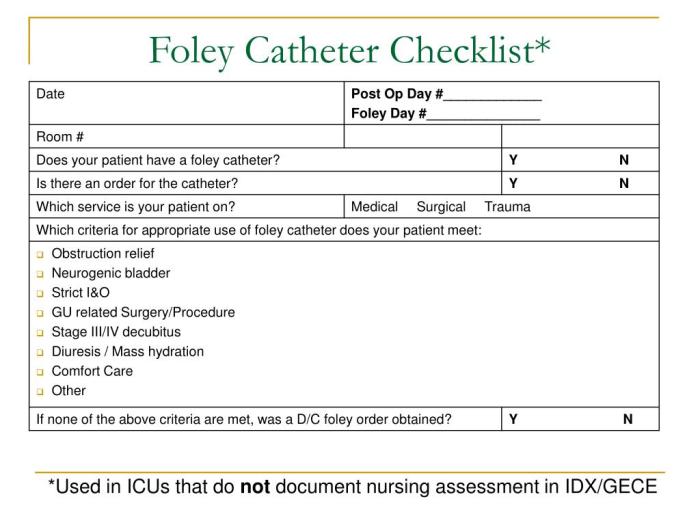Nursing notes charting urinary catheter documentation example – Accurate urinary catheter documentation is essential for effective patient care. This article provides a comprehensive overview of the essential elements of urinary catheter documentation, including patient identification, date and time of insertion, type of catheter used, insertion site, patency assessment, and output monitoring.
Additionally, we include an example of a well-documented urinary catheter insertion note using HTML table tags.
Proper monitoring and troubleshooting of urinary catheterization are also crucial. We discuss the signs and symptoms of urinary tract infection (UTI) related to catheterization and the importance of regular monitoring for potential complications such as infection, blockage, and dislodgement. Nursing interventions for preventing and managing these complications are also explored.
1. Nursing Notes Charting Urinary Catheter Documentation

Accurate urinary catheter documentation in nursing notes is crucial for patient safety and effective care. It provides a record of the procedure, facilitates communication among healthcare providers, and serves as legal documentation.
Essential Elements of Urinary Catheter Documentation
- Patient identification
- Date and time of insertion
- Type of catheter used
- Insertion site
- Patency assessment
- Output monitoring
Example of a Well-Documented Urinary Catheter Insertion Note
| Element | Documentation |
|---|---|
| Patient | Jane Doe |
| Date and time of insertion | 2023-03-08 14:00 |
| Type of catheter | Foley catheter, 14 Fr |
| Insertion site | Urethra |
| Patency assessment | Urine flows freely |
| Output monitoring | 100 ml per hour |
2. Monitoring and Troubleshooting Urinary Catheterization

Signs and Symptoms of UTI Related to Catheterization
- Cloudy or foul-smelling urine
- Frequent or painful urination
- Suprapubic pain or tenderness
- Fever
- Chills
Importance of Regular Monitoring for Potential Complications
- Infection
- Blockage
- Dislodgement
Nursing Interventions for Preventing and Managing Complications
- Maintaining sterile technique during insertion and care
- Monitoring urine output and assessing for signs of infection
- Irrigating the catheter as prescribed
- Securing the catheter properly
3. Catheter Care and Maintenance

Principles of Proper Urinary Catheter Care and Maintenance
Proper urinary catheter care and maintenance are essential to prevent infection and ensure optimal function.
Steps Involved in Catheter Care, Nursing notes charting urinary catheter documentation example
- Cleaning the catheter and insertion site
- Emptying and measuring urine output
- Irrigating the catheter
Frequency and Indications for Catheter Changes
The frequency of catheter changes varies depending on the type of catheter used and the patient’s condition. Indications for catheter changes include:
- Blockage
- Infection
- Dislodgement
4. Patient Education and Discharge Planning

Patient Education Responsibilities of Nurses
- Benefits and risks of urinary catheterization
- Self-care instructions
- Signs and symptoms of complications
Discharge Planning Considerations
- Follow-up appointments
- Catheter removal instructions
- Home care management
Top FAQs: Nursing Notes Charting Urinary Catheter Documentation Example
What are the essential elements of urinary catheter documentation?
Patient identification, date and time of insertion, type of catheter used, insertion site, patency assessment, and output monitoring.
What are the signs and symptoms of UTI related to catheterization?
Fever, chills, cloudy or foul-smelling urine, increased frequency or urgency of urination, and pain or burning during urination.
What are the nursing interventions for preventing and managing complications related to urinary catheterization?
Proper hand hygiene, sterile technique during insertion and maintenance, regular monitoring for signs and symptoms of infection or complications, and patient education.